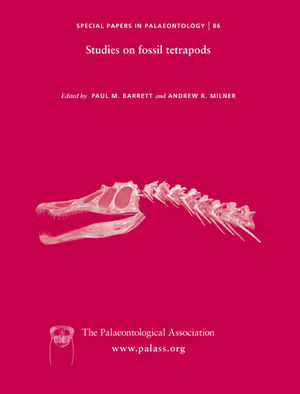Reg. Charity No. 1168330

A single specimen of a very small (snout-vent length < 50 mm) tetrapod represents the remains of a new microsaur from the Vise´an. Its most distinctive feature is the tail. Its holospondylous vertebrae have short neural arches, with the most anterior three caudal vertebrae having curved postsacral ribs, followed by four bearing long spatulate haemal arches. Dorsally and ventrally, the tail bears a deep fin supported by thinly ossified haemal arches revealed by ultraviolet photography, with skin impressions preserved as a black film. This type of preservation may be unique at the East Kirkton locality. The skin of the ventral fin shows fine striations and regular folding. Striations are also preserved on the dorsal part of the fin. Large, oval scales each with a thickened anterior edge appear to cover much of the body: they are very finely striated in a radiating pattern. There is a well-preserved relatively large pes with five stout digits and a short, very broad, ossified tarsus, although individual bones cannot be identified. Tail construction and the size of the pes, combined with the large scales, constitute unique features. The short presacral column has room for 22–25 holospondylous vertebrae. Ribs are slender and curved. No pectoral limbs or girdles are preserved, although a pelvic girdle has been identified. The skull is very poorly preserved precluding interpretation and description; however, two rows of marginal teeth are preserved in occlusion. The margin of a large orbit and the undulating lower posterior margin of the skull can be made out. Judging by its heavily ossified pes, the specimen was not a juvenile, but the deep tail suggests a swimmer. All known tetrapod groups except microsaurs can be ruled out on the basis of vertebral construction or proportions. Among microsaurs, a finned tail is present in Microbrachis, though that of the described specimen differs from it in detail. As a microsaur, it is both the earliest known species and the only one from the United Kingdom, although the internal phylogenetic relationships of ‘microsaurs’ remain controversial.